#once I design the characters I'll get to drawing them digitally haha
Note
Hi! I really love the way you color, and I was wondering If you could make a tutorial about it, I of course completely understand if you Can't/don't want to do it thanks in advance If you decided to do it and have a good day/night.
Hello hello!
Ooooh, a color tutorial! I've never done one before so I'm not sure if I'll be any good at it haha. But I don't mind sharing my thinking process when it comes to coloring my works.
So when it comes to color, I very much have a traditional painter's approach since that's how I learned color in art college. My painting professor never allowed us to use black or white paint, we could only use other colors to create darker colors or new colors altogether. And you're probably thinking, "What the hell? That's insane." And I wouldn't blame you haha. But this approach helped me a lot to not rely on tints (colors mixed with white) and shades (colors mixed with black) when I color. For the most part, I purely thinking about value and hues when I'm coloring.
Finding the right values:

So for this drawing, I did two different takes (one with direct harsh lighting and one without). The reason why I'm showing this is because when it comes to color it's very important that your values aren't clashing with each other. When I started out, all my coloring felt flat because I was using colors with the same values so there was little to no depth. A lot of people don't realize this but color does have value!
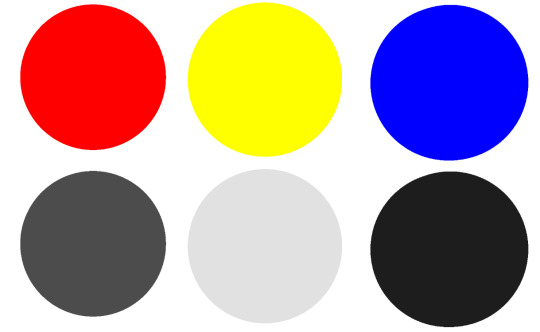
If we put the primary colors on greyscale, you notice how each color has its own value. Blue tends to be a dark value, red has a mid to dark value , and yellow is a much lighter value. This is why if you ever look at my work, the color I use for shadows lean into blue/purple tones. You can also have warm shadows since red does have a deeper value compared to yellow. But these values are when the primary colors are at the highest saturation. What would happen if we knocked down the saturation levels?

The values start to become more similar. Since we're not always using the most saturated colors, it's important to understand the values behind the colors you'll use. Once you unlock that, you can pretty much do whatever you want with color haha. That's why I hardly ever use black or white in my digital art when mixing (also I don't mix color with a brush, I just pick from the color wheel which might be insane).
While it's not wrong to use white or black to create darker/lighter colors, color in real life doesn't always act that way. Shadows and highlights can have color. For myself, letting go of white and black has opened a world of color combinations that I didn't think of before taking my first ever traditional painting class. Now, I can freely pick colors and experiment with palettes since I've blocked out what values I need (like the image below).

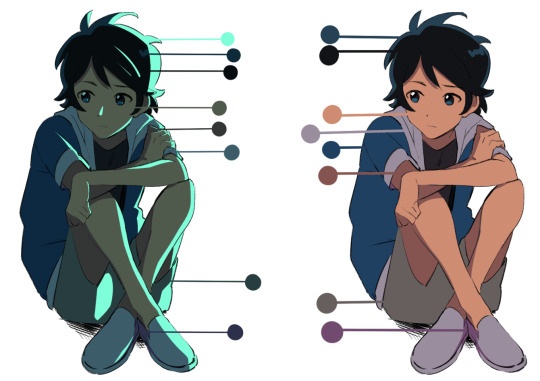
Even if I'm using blending modes like in the next image, I'm always thinking about making clear value separations. If I can't understand the image in black and white, then I'll have a hard time seeing it in color.

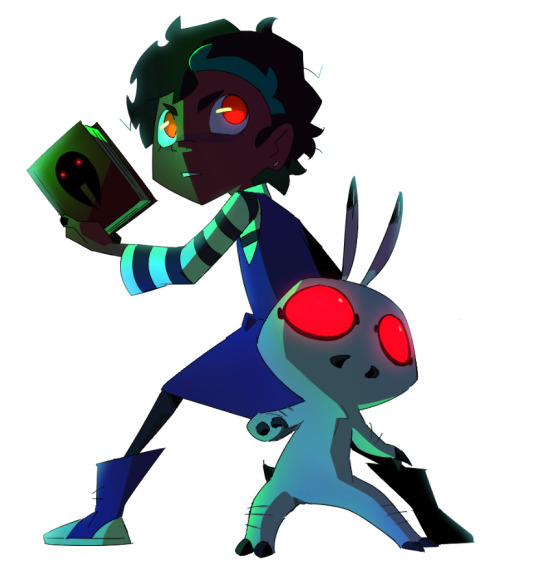
And when you get very comfortable, you can start placing characters in different color environments and match them (which essentially is the job of a color designer in TV animation).
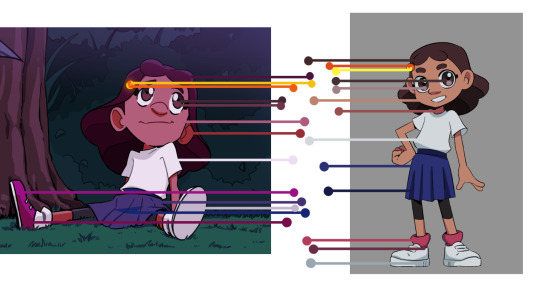
The right image is the official color palette for my character which already uses a lot of blue/purple for the shadows. But on the left side, she's in a night-time environment so I leaned even more into the cool colors to the point that the white T-shirt is actually a very very light purple/pink color haha.
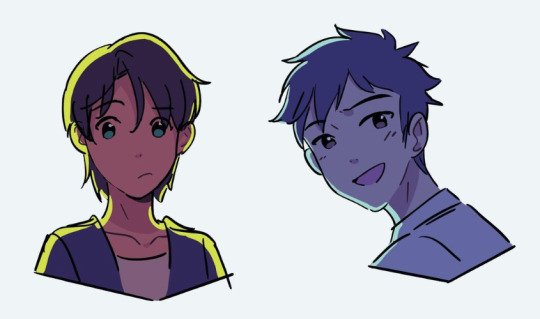
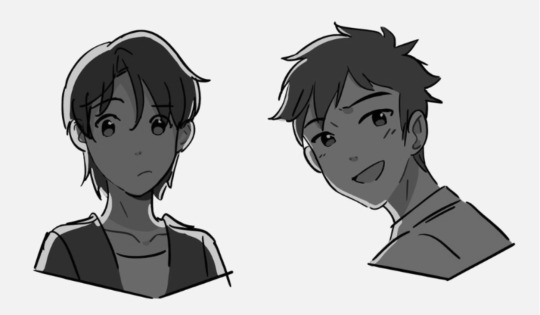
Or like this example where the left drawing gives a more sunset/golden hour lighting while the right one is more blue hour/night time lighting. But you can read the colors clearly 'cause the values are clear to begin with.
While that wasn't really a tutorial this is pretty much my thought process when I'm coloring my digital works. ^^; I very much do follow an academic approach to color theory but even then I think it's okay to break the rules. As long as you have understanding of colors' value, I think you'll be able to unlock any color style you want!
I hope that answered your question and was helpful!
#digital art#digital illustartion#color#anon#ask#send me anon#send me asks#color theory#tone and value
234 notes
·
View notes
Text
Jellyboy Doodles :)
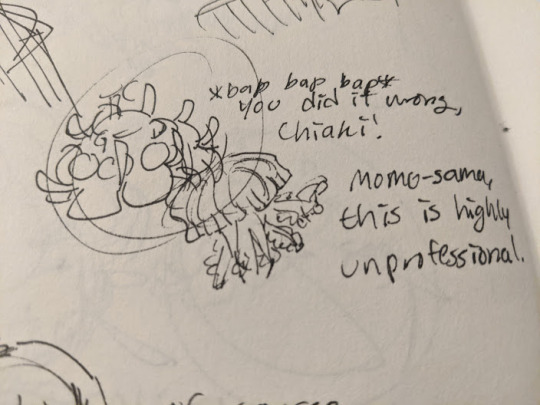
these two have a fun character dynamic... Hopefully I can explore that more later hehe
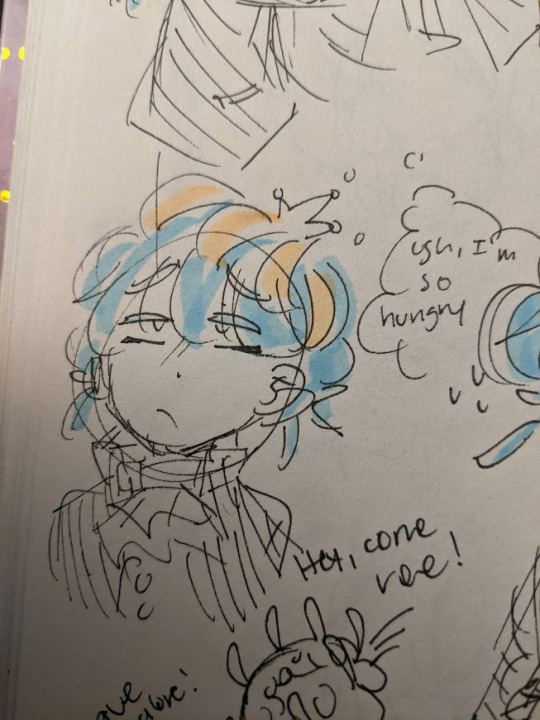
It’s legitimately so fun to draw I love you Momoka <33</p>
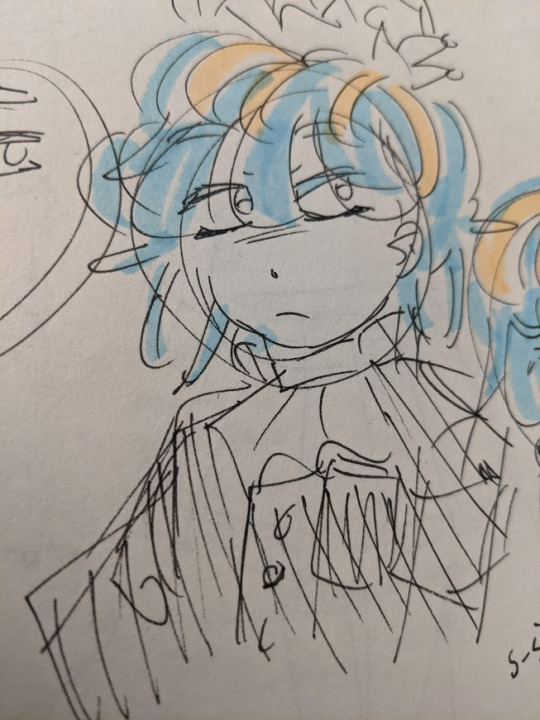
🥺🥺 those eyes are really fun

Momoka has a bit of an obsession with delinquents. They’d rather die than admit it, but he sort of looks up to Akuros.
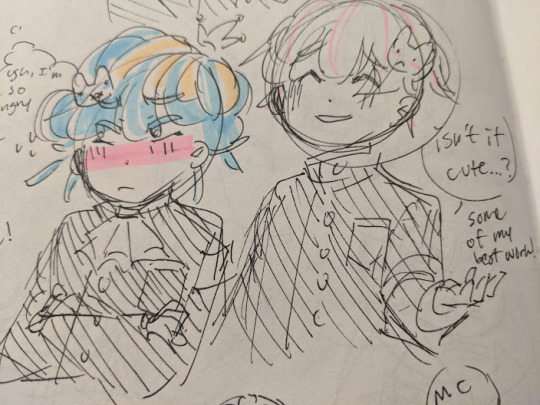
Haruto gets Momoka into trash collection asmr
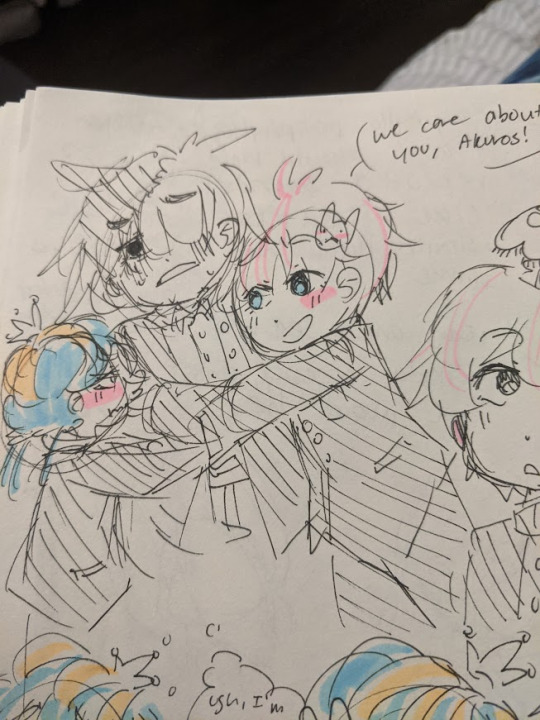
He’s...... yeah actually idk what he’s feeling but he deserves a hug
#these guys are in the same class so it's all fun :D#// except for Chiaki. they're a 3rd year student#i might've drawn Momoka a bit too short but it's ok they're fine lol#my art#jellyfish game#akuros irakusa#haruto mizuya#momoka amahiro#jellyfish#once I design the characters I'll get to drawing them digitally haha#i haven't drawn on digital for awhile tho so I hope you can forgive me for that#most of them have tan skin because they're pelagic species btw- though Chiaki definitely has the darkest skin#Ite! It's Jellyfish Love!#chiaki houshio#haruto mizunami
12 notes
·
View notes
Note
heyy!! i really like your work and think you're SUPER MEGA cool, and hope you get REALLY good at animating!! drawing is the first step, so making it move is the next haha. (once i save enough for a tablet i'll practice a lot!!) but i have a question: how do you improve as an artist? do you actively seek out critique or does it come with time and sub-conscious decisions to not do the bad thing anymore? what did you do? love you, keep fredding on!! ----some stupid idiot who wants to be anonymous

thank u anon this is super sweet!!! it means a lot<3
also ive been an animation student for 5 years now so i know a little bit but probably, less than i should.....i do Not practise enough
as for tips! let me try and compile a short list of things that help me!
• u hear it all the time but its true-practise practise practise!!! sketchbooks, digital, whatever strikes ur fancy. practising is the MOST important thing u can do
• understand and research the basics. you dont need to be an expert on anything, god knows im not, but its good to know a bit! this includes but isnt limited to:
colour theory! why colours go together, what colour schemes look good, etc. heres some basics on it! personally
[i also find symbolism of colour just as important. obviously symbolism varies from person to person and culture! but heres a quick guide on the usual symbolism of colour. if something sounds wrong to you though, mess with it yourself!]
tthe form of subjects-this means drawing basic shapes, and using them to construct [basically] anything! the idea is its much easier to draw and move around a series of cubes and cylinders, than a whole human body. heres a guide on how form works.
draw a box is a challenge recommended to me by my lecturer for improving on drawing shapes and forms! i highly recommend it!
value and lighting are important! heres an explanation on value. im not sure much can be done to cheat lighting and value, except for master studies (we’ll get to that shortly!) and observation.
the most useful tip on value ive learned, is to turn your art black and white, and see if it all has enough contrast without colour. if not, time to work on the values!
composition, babey. how subjects are arranged in a piece. heres a bunch of stuff on it [im still learning this one...rule of thirds i will Die for tho]
anatomy! this is the hardest shit. i still dont get it. my lecturers recommend andy loomis [heres a pdf of his figure drawing book] idt his way was quite up my alley, but u never know!
• speaking of anatomy-life drawing is an INCREDIBLY useful reference. so goddamn useful, u dont even know. they help u figure out anatomy! this includes gesture studies, and more detailed things. i recommend googling how a typical life drawing class goes down/tips for it
life drawing classes are very difficult to access atm, so here are a couple of online resources! [all of these will obv contain nude bodies]
croquis cafe-contains free videos that simulate a life drawing class! videos are more useful than images. has a variety of ethnicities and body types, which is wonderful!
line of action- a site with a variety of images on figure drawing, animal drawing, as well as hands & feet, expression/face focus, and environmental things. you can set it to play as a slideshow for as long as u like, or set it up to be similar in timing to a real life drawing class
online stock photo artists such as senshistock, who has compiled a useful little list of similar accounts over here!
• reference reference reference!! references are so incredibly useful, and anyone who tells you using a reference is cheating is wrong on every conceivable level. reference from photos, from movies, from videos, everything.
something ive had to do in every level of art education is recreations and master studies.
this means collecting artists work from professionals-be it historic painters, movie screenshots, concept artists, anything!
it makes you focus on their compositions, how the lighting works, the colours used, pretty much everything.
this is useful bc it can 1: get you out of your comfort zone and 2: make you use new techniques you might never have considered
online tools such as designdoll and justsketchme have poseable models for you to pose as you please and reference from! suuuuper useful, especially for perspective poses.
• experimentation! fuck around. use brushes youve never used before, try a new medium, collect every free sample from the craft store and just Do Shit with it.
• absorb every goddamn piece of art u have ever come across, and save what you enjoy.
and i mean save everything you enjoy. u like a movies lighting? a certain shot? an outfit? a random piece of fanart u came across? save it! look at it, figure out what it is u like
make a private pinterest board or a folder on ur computer, save everything.
absorb and yank bits from art u enjoy. obviously dont imitate someones entire style, but if u like the way someone draws hands, or noses, or eyes, reference it. recreate it. see what u like, and incorporate it into ur own art
art is a big mess of taking things u like and making it ur own
• study professionals! animations, artists, illustrators. they know what they’re doing.
heres a useful resource with a lot of rare concept art from animated movies! i go here a lot.
buy art books, or acquire pdfs of them, im not a cop, i dont care
• as for critique, i do look for critique, and pay attention to it, but it’s important to know not to take it personally. and i recommend asking people whos opinions you value!
i think thats all i can think of right now in terms of General Art....
if u want me to elaborate on anything or show me art, ask for help or just talk art stuff [character design is my fav and my speciality, ive been studying it for a while 👀] please dont be afraid to dm me or just send me another ask!
best of luck anon, i rly hope this helps! :D
5 notes
·
View notes